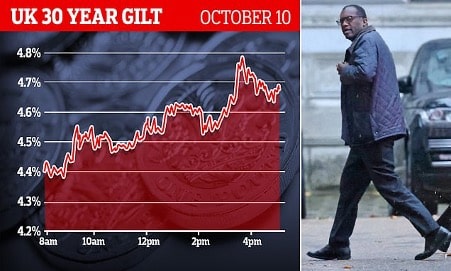So, £10 Billion a day is to be used by the Bank of England to purchase long dated Gilts to drive down yields and so save the UK pensions industry, did any of that make the slightest bit of sense to you?
I think I should break things down for you first and then try to explain in plain English what this means.
I could at first explain that the entire system of money is coming to an end and that we’re in a currency war, one that has been going on since 1913, but I’ve covered that in another article, and I suggest you read that one in conjunction with this one.
So, lets take this one step at a time. When the government talks about pensions, it’s an overarching term, in this context they’re talking about the lifetime income from Annuity contracts sold by the Insurance industry, by the likes of Aviva, L&G and the Prudential, to name but a few. So, it’s the Annuity market that’s having some issues.
So, what’s the problem they’re having?
Some years back Insurance companies were compelled for reasons of liquidity, to hold lower risk and therefore lower income producing, UK Gilt Edged securities. This reduced the level of income from annuities as they were holding more higher yielding corporate bonds and commercial property. These assets are used to pay the income for life, from the money paid to them via pensions pots that they invest in over a very long time. 30-year UK Gilts, or debt issued by the UK Government with the capital paid back in 30 years’ time with annual income called a coupon, pays much less than either corporate debt or commercial property rent, but it’s more liquid and AAA rated. This has led to much lower income from annuities, until just recently of course as interest rates have risen.
At the time it was good for the government to have a ready market for its debt, but now it’s not so good for the insurance industry, as the markets don’t believe the government will be able to pay back the debt in 30 years.
The first thing to understand is that we operate on a troubled Usury monetary system, that means the Bank of England and not the Treasury, creates money. This money has an interest to pay back to the central bank, but if the Treasury themselves created the money from thin air as the bank has it would be interest free. I’m sure you’re all wondering just why they don’t do just that, but you just don’t understand how the banks are in charge and not the government, do you?
So, as the Bank of England buys back bonds from the insurance industry at a rate of £10 Billion a day (365 x 10 would be £3.65 Trillion over a year) they add more pounds into the world, thus adding more inflation, inflation is caused by money creation from central banks and not pay rises for Nurses, just in case you fell for that old chestnut!
The apparent lack of an agreed plan for repayment of the Banks interest from the made up money they printed, has led to the second hand market in debt (those who buy the debt and sell it on or hold until maturity) to lose faith that they will get the capital back without the huge inflation eroding that money in 30 years’ time, and the feeling that an interest as low as 1.5% each year as poor compensation for what now looks like a damn higher risk than AAA. They are asking for a higher yield, one that’s rocketing up from 1.5% towards the 5% mark.
So, how do you get 4.5% from 1.5%?
In not very simple maths, because there is a dirty price and a clean price for the bonds, don’t worry we won’t go in that, you must sacrifice some of the returning capital to produce the desired yield. So, for example, if you have a five-year bond with a new yield of 4.5% from the original 1.5% the government has agreed to pay, you need 3% a year from capital to create the 4.5%, 3% and 1.5% = 4.5%.
So, if you have a bond worth £1 million pounds, it has lost 3% a year off the returning capital if you don’t want to hold it until maturity, and so 5×3 = 15% off the maturity amount. The person holding the bond has lost £150k if he wants to sell it, plus the 1.5% a year, and so another £75k from the lost income, a total loss of £225k. This is pretty terrible for such a low-risk asset and so the insurance firms have to sell off the debt as it’s risk and yield are now a risk to its capital requirements. The more they sell it off the higher the yield goes, and it creates a vicious circle of sell offs and ever-increasing yields.
I’ve done very simple math to make it understandable, so any Bond dealers out there can jog on! The point is this, the insurance industry is losing considerable value in the bonds that they hold, and as they try to sell it just makes matter worse, in fact the problem becomes fatal as the yields just keep shooting up as they hold a vast amount of this debt that nobody will accept at a price that isn’t a disaster for them.
So, the Bank of England is buying back this debt and in doing so creating more inflation, which in turn spooks the markets further, it’s a vicious circle. The markets don’t believe the Bank can just do this forever because it’s trashing the value of the pound, which costs us all dearly.
The Bank of Japan has been keeping its yields down for some time, doing the same as the BOE, so it’s not a shocker really. The difference is most of Japan’s debt is bought internally by Japanese savers, with us it’s the rest of the world and they just would prefer Dollars now.
Don’t get too excited and rush to buy Dollars, the Dollar could be described as the best-looking Mare in the knacker’s yard, in other words it’s just a matter of time before we see the same in the USA.
If you want to understand the state of currencies, then see my link to my blog called the Currency Crisis.


